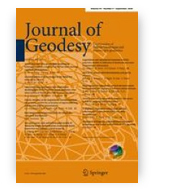Assessment of length-of-day and universal time predictions based on the results of the Second Earth Orientation Parameters Prediction Comparison Campaign
Justyna Śliwińska-Bronowicz; Tomasz Kur; Małgorzata Wińska; Henryk Dobslaw; Jolanta Nastula; Aleksander Partyka; Santiago Belda; Christian Bizouard; Dale Boggs; Sara Bruni; Lue Chen; Mike Chin; Sujata Dhar; Robert Dill; Jose Manuel Ferrandiz; Junyang Gou; Richard Gross; Sonia Guessoum; Songtao Han; Robert Heinkelmann; Christopher Irrgang; Mostafa Kiani Shahvandi; Jia Li; Marcin Ligas; Lintao Liu; Weitao Lu; Volker Mayer; Maciej Michalczak; Sadegh Modiri; Michiel Otten; Todd Ratcliff; Shrishail Raut; Jan Saynisch-Wagner; Matthias Schartner; Erik Schoenemann; Harald Schuh; Benedikt Soja; Xiaoqing Su; Daniela Thaller; Maik Thomas; Guocheng Wang; Yuanwei Wu; Xueqing Xu; Xinyu Yang; Xin Zhao; Zhijin Zhou
Journal of Geodesy
Ministerial score = 140.0
Journal Impact Factor (2023) = 4.4 (Q1)
 Predicting Earth Orientation Parameters (EOP) is crucial for precise positioning and navigation both on the Earth’s surface and in space. In recent years, many approaches have been developed to forecast EOP, incorporating observed EOP as well as information on the effective angular momentum (EAM) derived from numerical models of the atmosphere, oceans, and land-surface dynamics. The Second Earth Orientation Parameters Prediction Comparison Campaign (2nd EOP PCC) aimed to comprehensively evaluate EOP forecasts from many international participants and identify the most promising prediction methodologies. This paper presents the validation results of predictions for universal time and length-of-day variations submitted during the 2nd EOP PCC, providing an assessment of their accuracy and reliability. We conduct a detailed evaluation of all valid forecasts using the IERS 14 C04 solution provided by the International Earth Rotation and Reference Systems Service (IERS) as a reference and mean absolute error as the quality measure. Our analysis demonstrates that approaches based on machine learning or the combination of least squares and autoregression, with the use of EAM information as an additional input, provide the highest prediction accuracy for both investigated parameters. Utilizing precise EAM data and forecasts emerges as a pivotal factor in enhancing forecasting accuracy. Although several methods show some potential to outperform the IERS forecasts, the current standard predictions disseminated by IERS are highly reliable and can be fully recommended for operational purposes.
Predicting Earth Orientation Parameters (EOP) is crucial for precise positioning and navigation both on the Earth’s surface and in space. In recent years, many approaches have been developed to forecast EOP, incorporating observed EOP as well as information on the effective angular momentum (EAM) derived from numerical models of the atmosphere, oceans, and land-surface dynamics. The Second Earth Orientation Parameters Prediction Comparison Campaign (2nd EOP PCC) aimed to comprehensively evaluate EOP forecasts from many international participants and identify the most promising prediction methodologies. This paper presents the validation results of predictions for universal time and length-of-day variations submitted during the 2nd EOP PCC, providing an assessment of their accuracy and reliability. We conduct a detailed evaluation of all valid forecasts using the IERS 14 C04 solution provided by the International Earth Rotation and Reference Systems Service (IERS) as a reference and mean absolute error as the quality measure. Our analysis demonstrates that approaches based on machine learning or the combination of least squares and autoregression, with the use of EAM information as an additional input, provide the highest prediction accuracy for both investigated parameters. Utilizing precise EAM data and forecasts emerges as a pivotal factor in enhancing forecasting accuracy. Although several methods show some potential to outperform the IERS forecasts, the current standard predictions disseminated by IERS are highly reliable and can be fully recommended for operational purposes.
DOI:10.1007/s00190-024-01824-7









